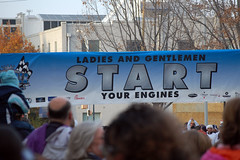 There’s something surreal about blogging by the campfire watching the sun rise. I’m out with my boys on a guys day out. Ok, I didn’t post this from the campfire but I could have since I had cell signal and can tether my phone… But I resisted the urge. What you’ve got here is what I happened to jot down while my boys were sleeping.
There’s something surreal about blogging by the campfire watching the sun rise. I’m out with my boys on a guys day out. Ok, I didn’t post this from the campfire but I could have since I had cell signal and can tether my phone… But I resisted the urge. What you’ve got here is what I happened to jot down while my boys were sleeping.
It’s been a while since I really went camping. I did it once last year but before that it had been at least 10 years. I grew up camping every summer. It’s been a goal of mine to get back to camping more often. This week, I promised my boys that we’d get out and do a guys night out. We packed up the tent and hit the grocery store to pick up hot dogs, marshmallows and all the essential camping supplies.
We learned two lessons that I thought I’d share. I’m sure that at some point, these stories and lessons will make it into a talk but for now, they will have to stand on their own.
Smores
One of the fantastic lessons that we learned on this trip is that even a bad smore is really good. I mean it really doesn’t matter if it’s neat or messy, if it has too much chocolate (as if there is such a state), the marshmallow is burnt or just lukewarm or anything other variation. There are really only two ways to screw up a smore. You can burn yourself and you can obsess about creating the perfect smore but if you relax and just let things flow, you really can’t screw it up.
This was especially evident as my 10 year old was war dancing around the fire singing – “I like mine crunchy crunchy… I like mine crunchy crunchy…” carrying his mighty marshmallow torch burning his black as the night while my 12 year old was searching for that perfect golden brown. The really good news was that when my 12 year old accidentally set his on fire – he wasn’t upset because it meant that he got to eat his smore quicker…
The lesson here is to stop trying for perfection. There are many different things in life where the only real way to screw it up is to obsess over it.
Second Fire
The second thing that we learned is that the second fire is a lot easier to start than the first. I remember as a kid around the age of 12 that I would get up before my parents and get the morning fire started. I thought I was so brilliant because it wouldn’t take long for me to get a nice little fire going. I would contrast that to the night before where my father had spent the better part of an hour getting the fire going, building up from newspaper to leaves to small twigs to medium sized sticks to real logs at some point, carefully coaxing the embers all along and creating a great bed for the fire.
I’ve created a number of fires since then and have come to understand the rituals that my father taught me when I was young. I was reminded, once again, last night that it’s not as easy as I thought as a kid to get that first fire going. The tough part is building up the strong base of solid and consistent heat from the bed of embers. Once that’s going, the fire will provide a wonderful glowing heat late into the night. As my father did, I buried the bed of embers in ashes.
When I got up this morning, well before the sunrise with a wonderful dew covering the ground, I went about the task of starting a fire to cook breakfast on. As when I was a kid, I scraped back the ashes and laid down a piece of the newspaper on the coals and before I could get the matches, it caught fire. I found myself scrambling to get twigs before it went out. Those caught fire instantly which set fire to the larger sticks and the logs. In a matter of 5 minutes or so, I was ready to cook breakfast. That was fantastic!
The lesson here is that if something is really easy, it’s often because the path has already been paved. Don’t compare your success with those that did it the first time.
Just Some Observations
Man I’ve gotten soft. Muscles that I had forgotten about are sore and I slept on an air mattress. How was my father not this sore? He took all of us camping and slept on the rocks in a sleeping bag. Honestly, as I get older and am trying to raise my children, I’m getting more and more impressed with my father.
Camping has gotten modern. There’s electricity, modern plumbing and costs $24 a night. For those playing the home game, that’s $168 a week or $672 a month. I could rent an apartment around here for that. I need to find some place more “rustic” and cheaper if we’re going to do this a lot more often.

 This past weekend was the
This past weekend was the 